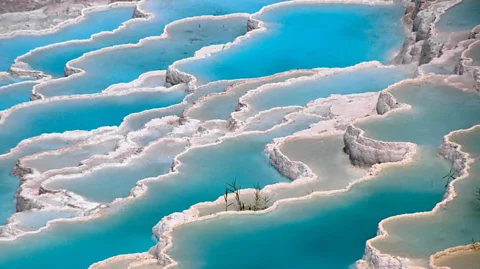Turkey's mysterious 'portal to the underworld'
 Dark_Eni/Getty Images
Dark_Eni/Getty ImagesThe ancient city of Hierapolis has long hidden a poisonous secret in its mysterious "Gate to Hell". But modern science has finally uncovered the truth behind the Roman myths.
In Pamukkale in western Turkey, an enormous white rock formation towers over the surrounding plain. The gleaming mountain of petrified limestone cascades to the valley floor, creased with frozen stalactites and tessellated with hundreds of pools of sparkling turquoise water.
These otherworldly formations are travertines, limestone cliffs slowly created over 400,000 years by the bubbling up of mineral springs. As the water flows down the hillside it degasses, leaving behind a vast deposit of bright white calcium carbonate that's almost 3km long and 160m high. This is not the only place where travertines occur – Huanglong in China and Mammoth Hot Springs in Yellowstone National Park are other famous examples – but the ones at Pamukkale are the largest and arguably the most magnificent in the world. They're one of the country's most popular visitor attractions, and are so spectacular that the Unesco World Heritage Site's name means "cotton castle" in Turkish.
Until the pandemic hit, more than 2.5 million people a year made the journey here from Izmir or Istanbul, spilling out of tour buses at the top of the dazzling plateau and swarming across the landscape like ants on a gigantic mound of sugar before piling back on board and heading on to the beaches of Bodrum or the historic ruins of Ephesus.
But visitors who simply dip their toes in the vivid mineral pools and take a selfie in front of the dripping natural columns before moving on are missing a trick. Because perched at the very top of Pamukkale's white crags sits an even more fascinating attraction: the ruins of the beautiful ancient city of Hierapolis.
Hierapolis was founded by the Attalid kings of Pergamon at the end of the 2nd Century BC before being taken over by the Romans in 133 AD. Under Roman rule, it became a thriving spa town; by the 3rd Century, visitors were coming from all over the Empire to ire the landscape and bathe in the supposedly healing waters. The success of the city is still visible in its impressive arched entrance gate, its colonnaded main street and its beautifully restored amphitheatre, all built from the same local travertine that glows golden in the hot Turkish sun.
 Feng Wei Photography/Getty Images
Feng Wei Photography/Getty Images"The thermal waters are likely one of the primary reasons for the city's foundation," said Dr Sarah Yeomans, an archaeologist at the University of Southern California who specialises in the Roman Empire. "By the mid-2nd Century, Hierapolis would have been a beautiful, bustling spa-town with what I imagine was a more dynamic and diverse population than most, given the popularity of such places with visitors."
But Hierapolis was also known throughout the Roman world for another, more sinister reason. It was said to be the location of a "Gate to Hell", a portal to the underworld where the toxic breath of the three-headed hellhound Cerberus flowed out of the ground, claiming unsuspecting victims on behalf of his master, the god Pluto. A shrine – the Ploutonion – was built on the site, and pilgrims travelled from across the region to pay the priests of the temple to make sacrifices to Pluto on their behalf.
You may also be interested in:
• The enduring allure of lost cities
Writers of the time, including Pliny the Elder and the Greek geographer Strabo, described these sacrifices as a chilling spectacle. A priest would lead an animal, perhaps a sheep or a bull, into the shrine. As if by the hand of the god, the animal would instantly drop dead, while the priest would walk out alive. "I threw in sparrows, and they immediately breathed their last and fell," wrote Strabo in Book 13 of his encyclopaedia Geography, clearly astonished by what he had just witnessed.
When you visit the Ploutonion today it's hard to imagine these dramatic scenes being real. Now excavated and restored, it's a tranquil place: a rectangular enclosure filled with about 25cm of sparkling clear water topped with gently drifting mineral foam, and a small arched entrance on one side. Above it is stepped seating for spectators, and a replica statue of Pluto gazes benignly down into the arena. When I visited, I couldn't understand how this could be a place of death? Surely these are made-up stories, I thought. How could the priests survive while the animals die?
These were questions that also intrigued Hardy Pfanz, a volcano biologist from 's University of Duisburg-Essen who studies geogenic gases – gases given off during geological processes. "When I read the descriptions from the ancient writers, I began wondering if there could be a scientific explanation," he said. "I wondered, could this Gate to Hell be a volcanic vent">window._taboola = window._taboola || []; _taboola.push({ mode: 'alternating-thumbnails-a', container: 'taboola-below-article', placement: 'Below Article', target_type: 'mix' });
